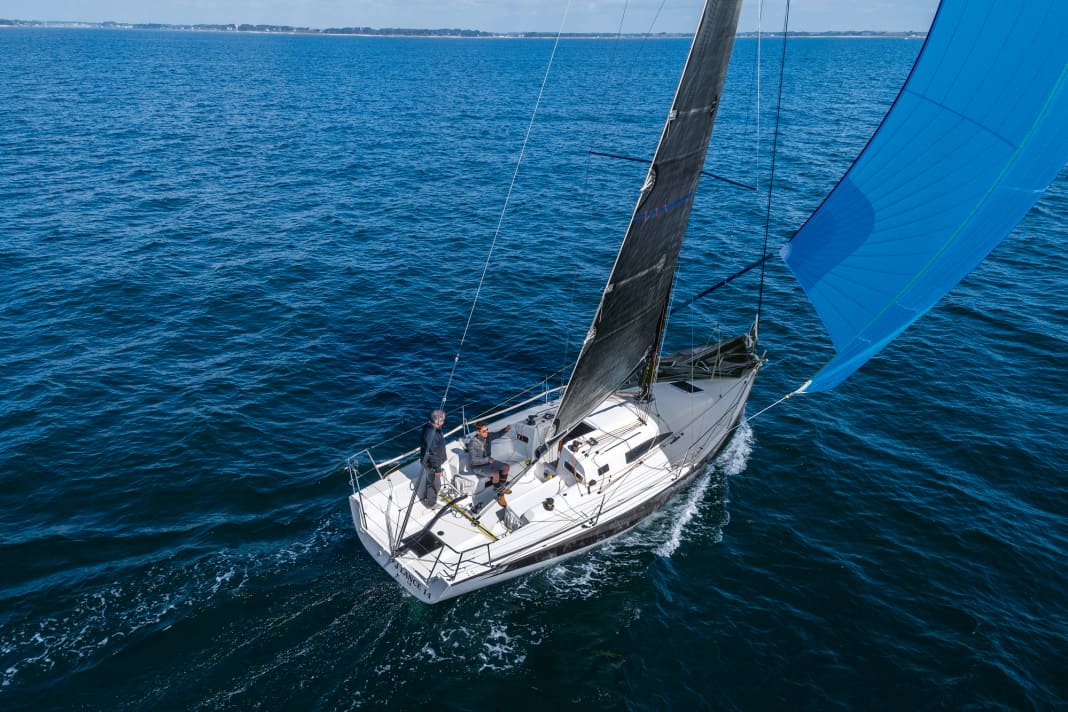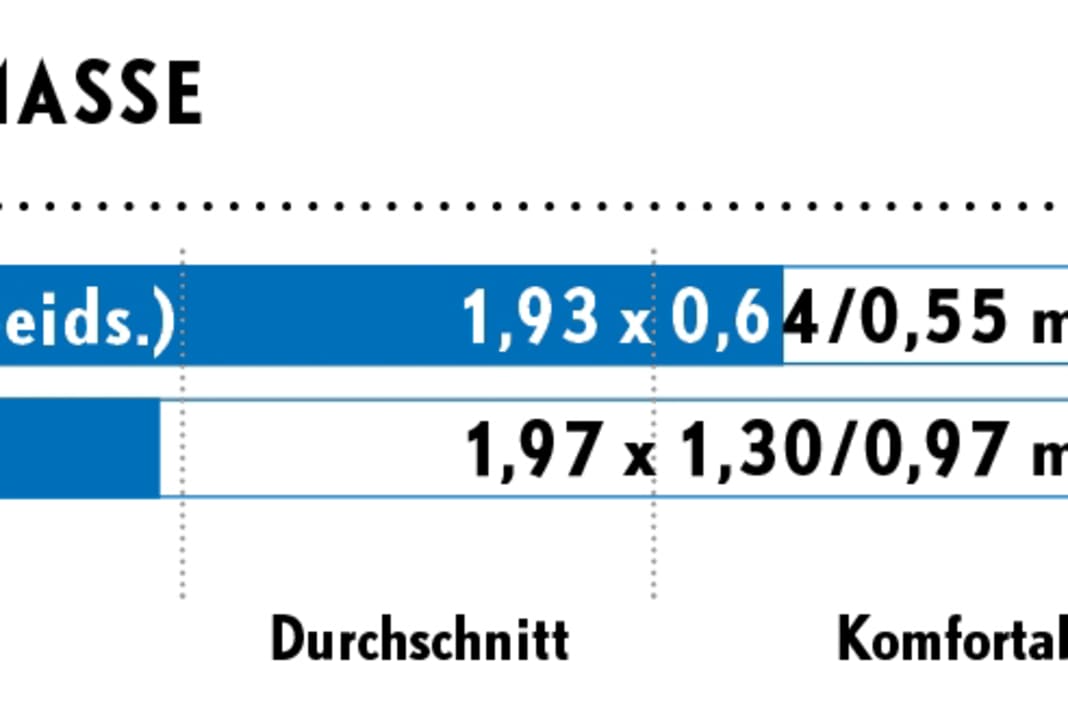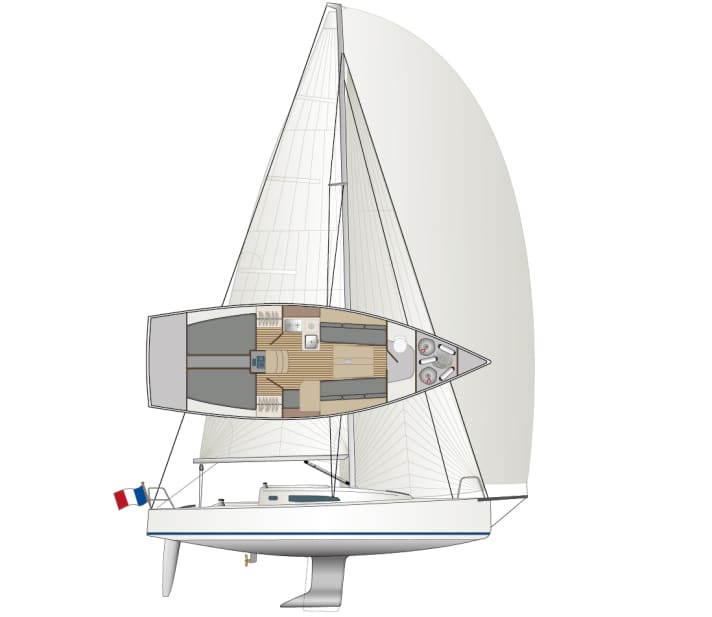





Alan Johnstone is responsible for the design of the J/99. And once again he does so without any notable surprises. In other words: the J/99 is also a typical J, from the stern to the bow. The moderate deck planing with the relatively low freeboard, the strikingly rounded bow shape and, above all, the lines that taper back towards the stern with the rather slender stern have generally characterised Johnstone's cracks for years.
In comparison with the increasingly radical, unusual and angular shapes of sporty competitor boats, the new model has an almost classic, conservative appearance - which is pleasing to the eye. The J/99 is attractive from the outside, with appealing lines and harmonious proportions. Customers appreciate that too.
More performance cruisers in the test:
The performance cruiser disregards formula constraints
The performance cruisers from J/Boats are therefore not designed with a specific measurement system (ORCi or IRC) in mind, but are instead geared towards maximising performance. Nevertheless, measurement and handicap are so important that the shipyard has given these topics a whole range of possible options. For example, the J/99 can be fitted with a fin keel instead of the standard L-keel, which favours the IRC rating.
And instead of the deep and slim rudder, two smaller steering fins are possible, which are installed further back close to the stern. They are the right choice for longer strokes in one-handed or two-handed mode. Integrated water ballast tanks are also available as an option.
The customer can also choose whether to equip the boat with a spinnaker or gennaker - or both. Accordingly, the bowsprit can be shorter (only 20 centimetres) or longer (up to a maximum of 1.30 metres).
Incidentally, with the J/99, the shipyard is now building a sports boat with a fixed bow nose for the first time ever and is breaking with its own tradition: the Johnstones virtually invented the long and laterally extendable bowsprit and made it ready for the market; the mobile trunk is still regarded as a trademark of J/Boats. The shipyard justifies the decision with weight savings due to the elimination of structural stiffeners in the bow area. In addition, water can no longer penetrate the ship through the guides of the bowsprit on long offshore trips.
D J/99 is powerful and rigid
YACHT was able to test the performance cruiser J/99 in beautiful spring weather, but unfortunately only in relatively light winds of between 8 and 10 knots, with hardly any waves. The boat runs at 6.3 knots at the cross and tacks at an angle of 80 degrees. This is within the range of what can be expected from a performance-orientated yacht of this type.
Equipped with the now rare spinnaker package, the boat also cuts a fine figure in the wind and can also sail deep courses thanks to the option of trimming the sail to windward. The J/99 achieves a top speed of 7.4 knots in these light wind conditions at an angle of 120 degrees to the true wind direction. Boats with a gennaker will have to sail higher to maintain this performance.




The J/99 sails very balanced and noticeably stiff, especially upwind. Both keel variants (L and fin) are similar in weight at around 1,600 kilograms, which corresponds to a comparatively high ballast ratio of almost 42 per cent. This is why the J weighs slightly more than the competition.
The helmsman and the mainsailer sit side by side and can operate the sheets and all important trimming devices from their positions. For two-handed regattas and long distances, the layout in the cockpit can be modified with little effort. For example, the genoa sheet can be folded over additional blocks and also operated upwind.
The fittings are fitted to the boat straight from the boatyard. The 3D haul-out points are also included in the scope of delivery. The complicated, but very efficient, towing system is redirected to the cabin roof on the opposite side and is operated by the crew on the high edge.
The J/99 performance cruiser is technically mature
The option of additional hatches on the flanks of the dents and on the cabin bulkhead is exemplary. On the one hand, this provides more light below deck and, on the other, offers the option of elegantly concealing the loose ends of the many halyards, sheets and trim lines.
Tiller steering is the standard. The rudder head is positioned far aft at the stern and is not directly connected to the rudder shaft, which is located around 70 centimetres further forward. A push rod is used for coupling, with two rudder blades correspondingly two.
The list of options also includes single wheel steering, but this seems absurd with this cockpit layout and orientation: a single wheel in the centre would be almost impossible to grip from the side from the seating positions, and double wheel steering is not feasible. However, J/Composites still wants to offer wheel steering as an option, especially for the USA.
The mechanics of the controls are easily accessible through a hatch in the rear cockpit area. However, the system is installed openly, i.e. without a cover or additional bulkheads. This eliminates the aft peak as storage space - the risk of fenders or mooring lines getting tangled up in the controls is too great. This is unfortunate because there are no other storage spaces in the cockpit for larger or smaller items.
The aluminium rigging of the J/99 deserves a special mention: the manufacturer AG+ has developed a profile with an attached groove exclusively for J/Composites, which is not screwed on but extruded together with the tube in one piece. This gives the mast additional strength and reduces the weight. The mast profile, which rests on the keel, weighs just 71 kilograms - excluding standing and running rigging - which is very similar to a similarly sized carbon fibre mast. A carbon rig is available as an option, although it is not explicitly mentioned on the list of options.
Less is also more with this performance cruiser
Beyond the companionway, you are greeted by a straightforward, no-frills and sober-looking interior. The shipyard has left no doubt about the J/99's focus on performance when it comes to the interior design, which is why comfortable cosiness is not an issue below deck - quite deliberately. Instead, the interior is dominated by simple but practical functionality. Nevertheless, anyone who can accept compromises when it comes to comfort will definitely discover the J/99 as a home boat, even for a trip with the family.
The layout in the saloon and aft of this performance cruiser is symmetrical. However, with a width of 1.30 metres at shoulder height, the berths in the aft cabins are only partially suitable for double occupancy. You can sleep comfortably on the sofa berths in the saloon, which are long and wide enough if you remove the back cushions.
As an option, these can be designed so that they can be folded upwards and fixed to the cabin roof with a length-adjustable strap. This results in spacious, open storage compartments, which are particularly useful for regatta sailors for their large bags than small storage compartments in drawers or boxes.
The foredeck, on the other hand, remains completely empty apart from a free-standing toilet. This is where the sails can and should be stored or other items for which there is no storage space on deck. If you also want to use your J/99 for cruising, you could have an additional berth installed, for example for the children. The effort required for this would be comparatively manageable, as the bunk storage could rest on the side stringers. However, this option is not specifically communicated by the manufacturer.
A performance cruiser at a fair price
For reasons of weight, J/Composites has dispensed with inner shells for the interior below deck, which leaves behind unsightly surfaces with rough structures; protruding screws for the fittings on deck are simply painted over with topcoat. Regatta sailors probably don't mind, provided they don't bump their heads on the sharp-edged protrusions in the cabins. More annoying is the disorganised and poorly labelled cabling, especially behind the electrical panel.
The basic ex-shipyard price for this performance cruiser is 165,290 euros without sails (as of 6/23). This puts the J/99 in the golden mean in terms of price. However, as is usual with performance boats, this does not include the cost of the sails. A simple set (main and genoa only) will cost at least an additional 10,000 euros for a boat of this size. A regatta-suitable wardrobe with a flat and a deep genoa, plus a spinnaker and/or gennaker, will put an even greater strain on the budget.
The J/99 in detail

Technical data
- Designer Alan Johnstone
- CE design category A
- Hull length 9.94 m
- Width 3.40 m
- Draught 1.99 m
- Weight 3.8 tonnes
- Ballast/proportion 1.6 t/41.6 %
- Mainsail 32.9 m²
- Genoa (105 %) 26.3 m²
- Engine (Volvo P.) 13 kW/20 hp
Hull and deck construction
- GRP sandwich construction with foam core built using a vacuum
infusion process with vinyl ester resin
Price
- Base price ex shipyard 165,290 euros without sails
Guarantee/against osmosis
- 5/10 years
Shipyard
- J/Composites, Olonne sur Mer (France); www.jcomposites.eu
Distribution
- Mittelmann's shipyard, Kappeln; www.mittelmannswerft.de
YACHT rating
Powerful competition boat for the performance cruiser class with a hull length of around ten metres. The boat is convertible, depending on use and measurement system. Competitive pricing
Design and concept
- + Uncompromising sports concept
- + Attractive lines
- - Lack of storage space in the cockpit
Sailing performance and trim
- + Perfectly realised cockpit layout
- + Sails noticeably stiff in the wind
- + Very efficient trimming devices
Living and finishing quality
- + Functional interior fittings
- - Unsightly surfaces below deck
Equipment and technology
- + High-quality basic equipment
- + Bowsprit in various lengths
- - Inadequate electrical wiring

